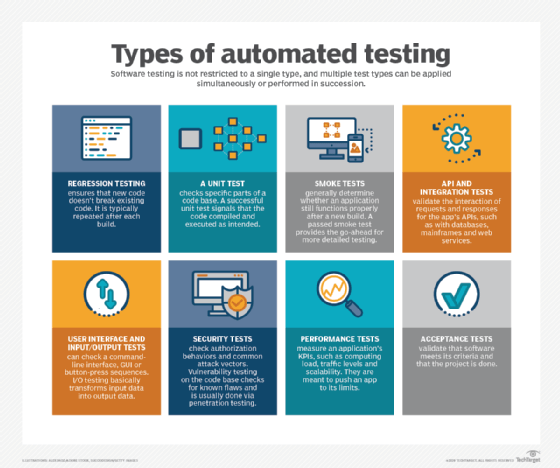Grasping Automation Testing: Tools, Methods, and Advantages
Grasping Automation Testing: Tools, Methods, and Advantages
Blog Article
From Manual to Automated Testing: A Comprehensive Guide to Transitioning Smoothly and Effectively
In the realm of software testing, the shift from handbook to automated processes has become an increasingly important shift for organizations seeking to enhance efficiency and precision in their screening techniques. As modern technology remains to development, the requirement for seamless and effective computerized screening techniques has never ever been a lot more pressing. The journey from handbook to automated testing is not without its challenges, but when come close to tactically and with a clear plan in mind, the advantages can be substantial - automation testing. In this comprehensive overview, we will explore vital actions and considerations important for a successful change, from the preliminary option of devices to the integration of automation right into existing operations. Remain tuned to uncover the understandings that will help lead the way for a smoother and more reliable testing process.
Advantages of Automated Evaluating
Automated testing uses numerous advantages, improving effectiveness and precision in software program development processes. Automated tests can be run concurrently on several tools and running systems, considerably speeding up the screening stage contrasted to hand-operated testing.
In addition, automated testing guarantees a higher level of accuracy in finding flaws. Given that automated examinations adhere to predefined manuscripts, human mistake is reduced, leading to more reputable examination outcomes. Consistency in testing is also boosted, as automated tests implement the exact same actions precisely each time they are run. This consistency is essential in ensuring that all performances of the software are extensively examined, reducing the possibility of undiscovered bugs slipping via to production.
Picking the Right Tools

To start with, assess your needs and goals. Comprehend the scope of your job, the modern technologies included, and the skill set of your group. This analysis will aid you determine the capacities and features you need in your screening tools.
Secondly, think about the compatibility of the tools with your existing systems and procedures. Seamless integration with your existing software application growth lifecycle is necessary to ensure a smooth change to automation.
In addition, assess the scalability and flexibility of the tools. As your testing requires evolve, the tools need to have the ability to adjust and fit modifications effectively.
Lastly, consider the support and community around the devices. When executing automated screening, durable assistance and an active user area can provide valuable sources and aid. By carefully thinking about these aspects, you can select the right tools that align with your demands and set the stage for a successful transition to automated screening.
Writing Efficient Test Manuscripts

When crafting test scripts, it is important to consider the specific needs of the software application being tested and make certain that the manuscripts attend to all vital functionalities. Clear and descriptive calling conventions for test manuscripts and examination cases can improve readability and maintainability. Additionally, including mistake handling devices within the test scripts can aid in web link identifying and addressing concerns without delay.
In addition, organizing examination scripts into modular parts can improve reusability and scalability, minimizing redundancy and enhancing performance in test manuscript upkeep. Routine reviews and updates to check scripts are essential to maintain speed with developing software demands and capabilities. By following these concepts, testers can create durable and effective test scripts that add significantly to the success of automated screening procedures.
Integrating Automation Into Workflows
Efficient integration of automation devices into existing workflows boosts and enhances processes performance within software program advancement cycles. When integrating automation right into operations, it is critical to identify recurring tasks that can be automated to conserve time and reduce human mistake. By perfectly incorporating automated screening devices like Selenium or Appium into the software application growth lifecycle, teams can achieve faster responses on code modifications, resulting in quicker pest discovery and resolution. This combination allows for continuous screening throughout the growth procedure, ensuring that any kind of issues are recognized at an early stage, causing greater software quality. Furthermore, automation can be made use of to activate examinations instantly after each code commit, providing instant recognition and liberating testers to concentrate on even helpful site more complex situations. Proper integration of automation devices needs collaboration between advancement, screening, and operations groups to develop a unified workflow that optimizes effectiveness and effectiveness in additional hints delivering high-grade software.
Making Certain a Smooth Change
Efficiently transitioning to automated testing includes thorough planning and mindful execution to make the most of and decrease disturbances efficiency in the software development procedure - automation testing. To guarantee a smooth shift, it is necessary to begin by conducting a detailed analysis of the present testing procedures and determining locations where automation can bring one of the most substantial advantages. Engaging with all stakeholders early on at the same time, consisting of developers, testers, and task managers, is important for gathering support and buy-in for the automation initiative
Communication is essential throughout this shift stage. Clear interaction of the goals, benefits, and expectations of automated screening assists to handle any type of resistance or issues that might develop. In addition, supplying sufficient training and sources for employee to upskill in automation devices and strategies is essential for making certain a successful shift.

Conclusion
Finally, transitioning from manual to automated testing uses numerous benefits, including raised efficiency and dependability. By picking the appropriate tools, composing reliable examination manuscripts, and incorporating automation effortlessly right into workflows, organizations can guarantee a smooth and successful transition. It is important to accept automation as a useful property in software program screening processes to improve general top quality and efficiency.
In the realm of software screening, the shift from handbook to automated procedures has actually become a progressively crucial change for companies seeking to enhance performance and accuracy in their testing methods. Automated tests can be run at the same time on multiple devices and running systems, substantially speeding up the screening phase compared to hands-on screening. Consistency in testing is also boosted, as automated tests execute the same steps exactly each time they are run.To make certain the effective implementation of chosen testing devices, the production of efficient test scripts plays an essential function in verifying the functionality and performance of automated processes - automation testing. By following these principles, testers can develop reliable and robust test manuscripts that contribute dramatically to the success of automated screening procedures
Report this page